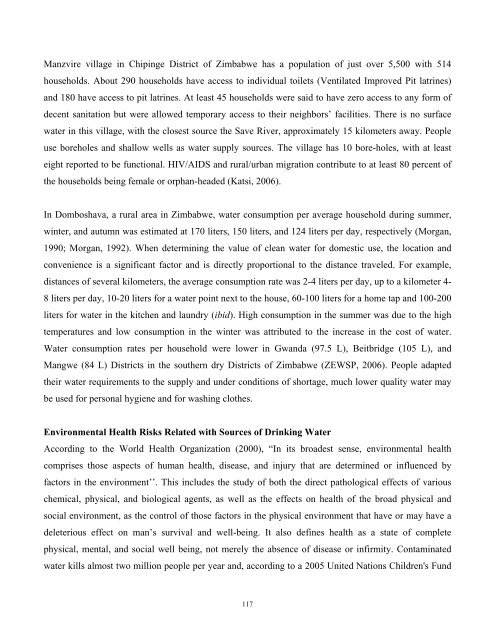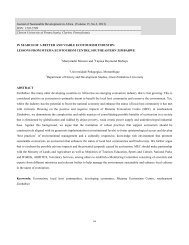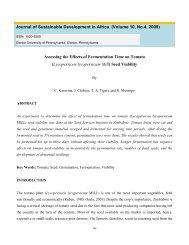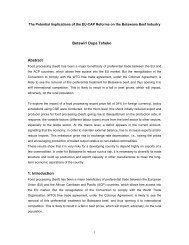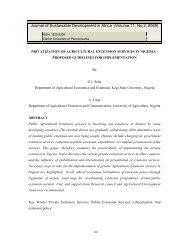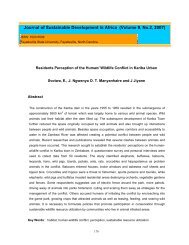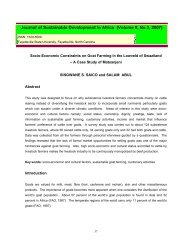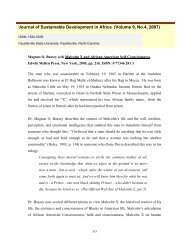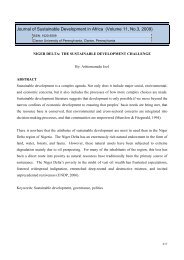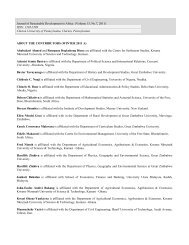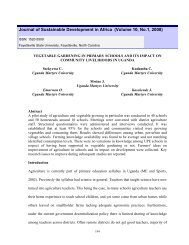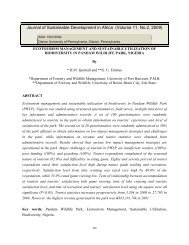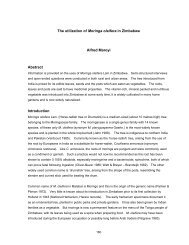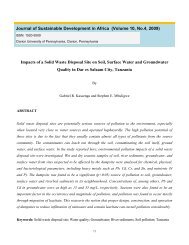Access to Safe Drinking Water by Rural Communities in Zimbabwe
Access to Safe Drinking Water by Rural Communities in Zimbabwe
Access to Safe Drinking Water by Rural Communities in Zimbabwe
Create successful ePaper yourself
Turn your PDF publications into a flip-book with our unique Google optimized e-Paper software.
Manzvire village <strong>in</strong> Chip<strong>in</strong>ge District of <strong>Zimbabwe</strong> has a population of just over 5,500 with 514<br />
households. About 290 households have access <strong>to</strong> <strong>in</strong>dividual <strong>to</strong>ilets (Ventilated Improved Pit latr<strong>in</strong>es)<br />
and 180 have access <strong>to</strong> pit latr<strong>in</strong>es. At least 45 households were said <strong>to</strong> have zero access <strong>to</strong> any form of<br />
decent sanitation but were allowed temporary access <strong>to</strong> their neighbors’ facilities. There is no surface<br />
water <strong>in</strong> this village, with the closest source the Save River, approximately 15 kilometers away. People<br />
use boreholes and shallow wells as water supply sources. The village has 10 bore-holes, with at least<br />
eight reported <strong>to</strong> be functional. HIV/AIDS and rural/urban migration contribute <strong>to</strong> at least 80 percent of<br />
the households be<strong>in</strong>g female or orphan-headed (Katsi, 2006).<br />
In Domboshava, a rural area <strong>in</strong> <strong>Zimbabwe</strong>, water consumption per average household dur<strong>in</strong>g summer,<br />
w<strong>in</strong>ter, and autumn was estimated at 170 liters, 150 liters, and 124 liters per day, respectively (Morgan,<br />
1990; Morgan, 1992). When determ<strong>in</strong><strong>in</strong>g the value of clean water for domestic use, the location and<br />
convenience is a significant fac<strong>to</strong>r and is directly proportional <strong>to</strong> the distance traveled. For example,<br />
distances of several kilometers, the average consumption rate was 2-4 liters per day, up <strong>to</strong> a kilometer 4-<br />
8 liters per day, 10-20 liters for a water po<strong>in</strong>t next <strong>to</strong> the house, 60-100 liters for a home tap and 100-200<br />
liters for water <strong>in</strong> the kitchen and laundry (ibid). High consumption <strong>in</strong> the summer was due <strong>to</strong> the high<br />
temperatures and low consumption <strong>in</strong> the w<strong>in</strong>ter was attributed <strong>to</strong> the <strong>in</strong>crease <strong>in</strong> the cost of water.<br />
<strong>Water</strong> consumption rates per household were lower <strong>in</strong> Gwanda (97.5 L), Beitbridge (105 L), and<br />
Mangwe (84 L) Districts <strong>in</strong> the southern dry Districts of <strong>Zimbabwe</strong> (ZEWSP, 2006). People adapted<br />
their water requirements <strong>to</strong> the supply and under conditions of shortage, much lower quality water may<br />
be used for personal hygiene and for wash<strong>in</strong>g clothes.<br />
Environmental Health Risks Related with Sources of <strong>Dr<strong>in</strong>k<strong>in</strong>g</strong> <strong>Water</strong><br />
Accord<strong>in</strong>g <strong>to</strong> the World Health Organization (2000), “In its broadest sense, environmental health<br />
comprises those aspects of human health, disease, and <strong>in</strong>jury that are determ<strong>in</strong>ed or <strong>in</strong>fluenced <strong>by</strong><br />
fac<strong>to</strong>rs <strong>in</strong> the environment’’. This <strong>in</strong>cludes the study of both the direct pathological effects of various<br />
chemical, physical, and biological agents, as well as the effects on health of the broad physical and<br />
social environment, as the control of those fac<strong>to</strong>rs <strong>in</strong> the physical environment that have or may have a<br />
deleterious effect on man’s survival and well-be<strong>in</strong>g. It also def<strong>in</strong>es health as a state of complete<br />
physical, mental, and social well be<strong>in</strong>g, not merely the absence of disease or <strong>in</strong>firmity. Contam<strong>in</strong>ated<br />
water kills almost two million people per year and, accord<strong>in</strong>g <strong>to</strong> a 2005 United Nations Children's Fund<br />
117


